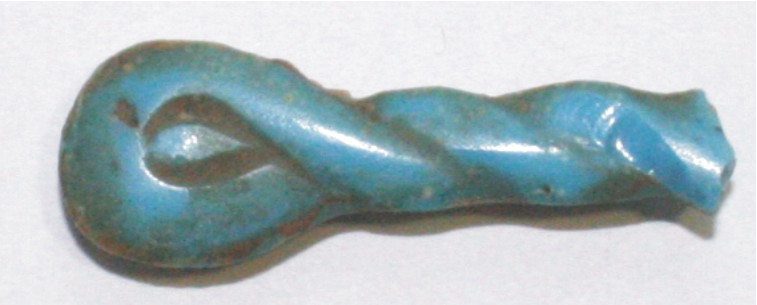Amarna glass
Amarna glass
Although, as Paul Nicholson states, Amarna is important for understanding glass working in Egypt (Nicholson and Peltenburg 2000, 183), we have only one piece of glass in the Egypt Centre which probably comes from this site. However, given that very little glass is known for this period its lack is not surprising.
 W244 inlay in the shape of an Egyptian ‘h’ sign. Blue glass. Purchased by Wellcome at auction in 1930. Perhaps a piece of furniture inlay (Bianchi 1993). This is on display in the glass section.
W244 inlay in the shape of an Egyptian ‘h’ sign. Blue glass. Purchased by Wellcome at auction in 1930. Perhaps a piece of furniture inlay (Bianchi 1993). This is on display in the glass section.
There are other pieces of glass which are in the Egypt Centre and are stylistically 18th Dynasty but we cannot be sure of the site.
_______________________________________________________________
The earliest glass in Egypt dates to around 1500 BC and is of a very high quality. That some of the words for glass in Egyptian are Hurrian or Arkadian has led to the belief that the early glass was imported. Indeed the Amarna letters mention imported glass. Soon after it appears that there is some evidence of actual working but as there is no experimental period it has been suggested that this glass was made by foreign glass workers, perhaps brought over by Tuthmosis III (1479-1425 BC).
Early glass is often treated like stone and may be cut like a gemstone rather than blown or moulded. An 18th Dynasty kohl pot of glass in the British Museum was solid cast and then had its interior drilled out like stone. Glass sickle blades were made in the same way as flint sickle blades in the tomb of Tutankhamun. Indeed, one of the words for glass in ancient Egyptian is ‘the stone that flows’.
Petrie believed the glass was made at Amarna and outlined a possible method. However, there has been some dispute as to how this was carried out and some recent commentators believe that during the Amarna Period glass was imported into Egypt. Nicholson (1998, 809), however, believes that while we do not understand the details of glass production at Amarna we have kilns probably used in production of frit. These kilns are much larger than known pottery kilns and contain slag showing they were heated to much higher temperatures than would be necessary for faience production. He also states all stages in glass production were present at Amarna but there are very few actual finds of glass, as it was a novel material.
Egyptian glass was made from the same materials as faience, that is silica, natron/plant ash and lime. Like faience, it was also coloured from cobalt (see information sheet on faience for where these were procured). It also seems that the production of faience and glass was carried out side by side.
Briefly, in glass production, the raw materials would be ground together and then heated in a process called ‘fritting’. This needs temperatures of 750-850 degrees. The fritting process allows gases to escape so that bubbles do not appear in the glass. The frit would then be allowed to cool and ground up. The material would then be placed in vessels and heated to between 1,000 and 1,200 degrees c. At this temperature the glass would be a sticky mass. Cooling, regrinding and reheating might be necessary to remove more air bubbles. The glass ingots would then be broken up and worked. At Amarna a number of rods or canes of glass were found.
Further Reading
Bianchi, R.S. 1983. Those ubiquitous glass inlays from pharaonic Egypt, Part 1. Journal of Glass Studies 25, 29-35.
Nicholson, P.T. 1998. Glass and glazing at Tell el-Amarna. In Eyre, C.J. Proceedings of the Seventh Iinternational Congress of Egyptologists. Cambridge, 3-9 September 1995. Leuven: Peeter, 805-812.
Nicholson, P.T. 2007. Brilliant Things for Akhenaten. The Production of glass, vitreous materials and pottery at Amarna site 045.1. London: Egypt Exploration Society.
Nicholson, P.T. and Henderson, J. 2000. Glass. In Nicholson, P.T. and Shaw, I. Ancient Egyptian Materials and Technology. Cambridge: Cambridge University Press, 195-224.
Nicholson, P.T. and Peltenburg, E. 2000. Egyptian faience. In Nicholson, P.T. and Shaw, I. Ancient Egyptian Materials and Technology. Cambridge: Cambridge University Press, 177-194.